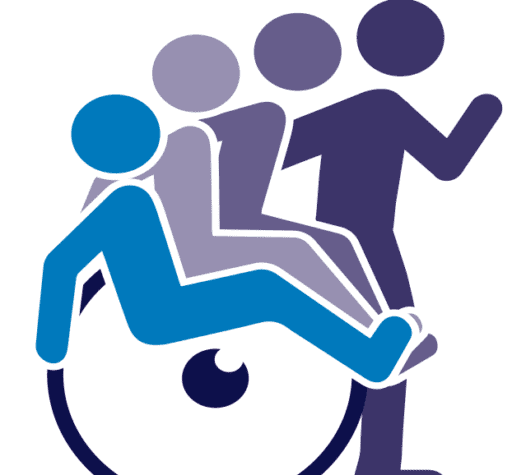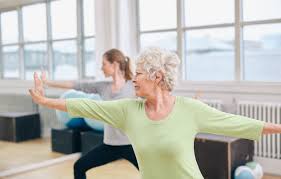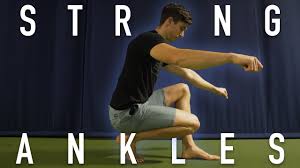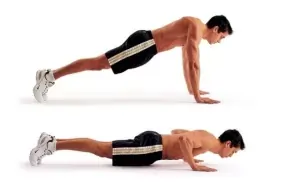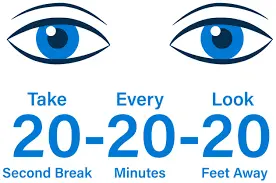Best Exercise For Overall Health at Home
Table of Contents
Introduction:
It’s not always necessary to have a gym membership or purchase pricey equipment to maintain general health. You may do efficient workouts at home that enhance your strength, flexibility, endurance, and mental health with only a little room and a little drive.
These workouts improve heart health, bone density, and mood in addition to helping with weight management and immunity. Including the greatest at-home workouts in your daily routine may have a big impact on your general health, regardless of your level of experience.
Best Exercise For Overall Health at Home:
Swimming:
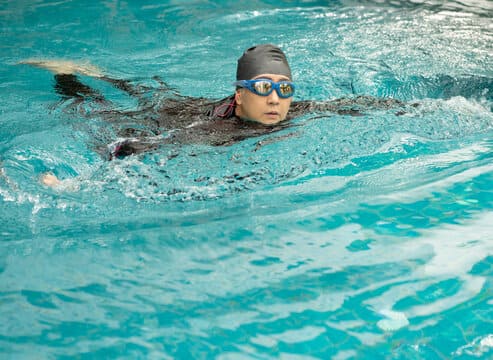
It puts less strain on the joints while strengthening the muscles, enhancing cardiovascular endurance, and expanding lung capacity. Swimming is a great way to increase general strength and endurance since it works practically all of the major muscular groups, including the arms, legs, back, and core.
Additionally, it enhances balance, coordination, and flexibility. Swimming is excellent for both physical and mental health as it may also lower stress, improve mood, and encourage better sleep. Swimming is a great workout for people of all ages, whether they want to do it as water aerobics or pool laps.
Tai chi:
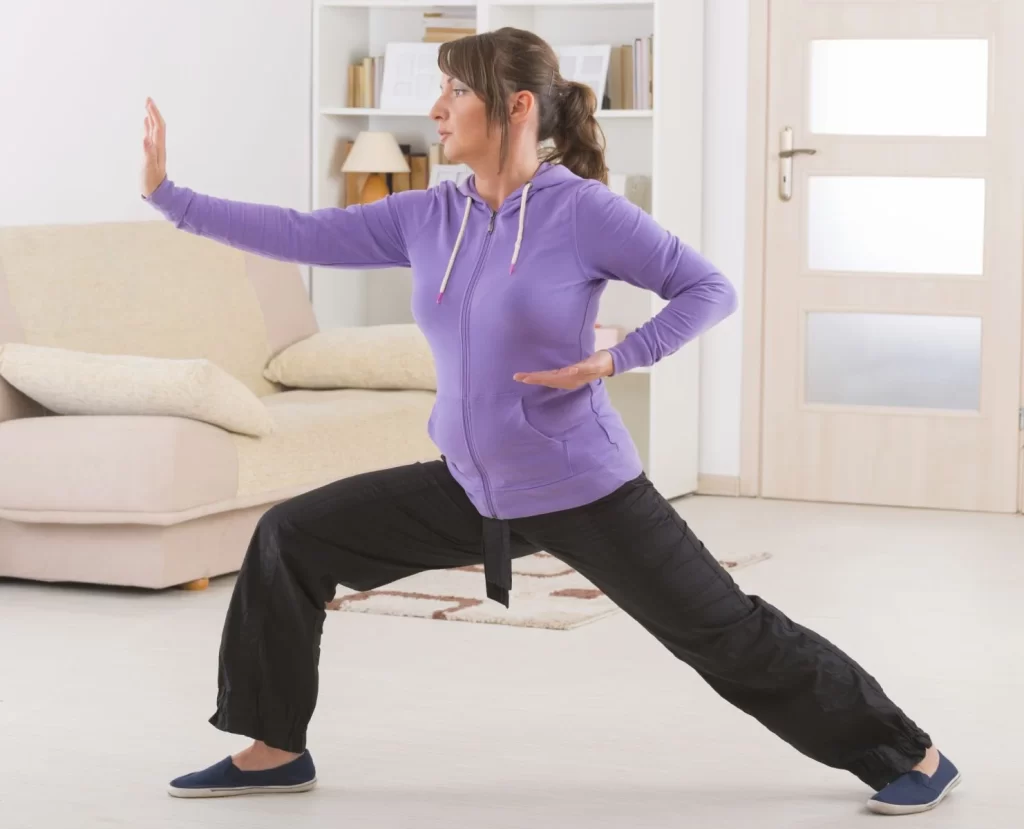
Because yoga improves coordination and lowers the risk of falls, it is especially advantageous for older persons. Additionally, tai chi enhances posture, fosters a clear, concentrated mind, and supports cardiovascular health.
Tai Chi is a great option for preserving general health at home because it doesn’t require any special equipment and can be done in a small area.
Strength training:
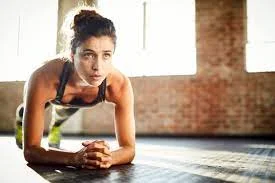
At-home strength training is an effective method for increasing metabolism, bone density, and muscle mass. It includes challenging muscles and promoting development by utilizing resistance, such as body weight, resistance bands, or dumbbells. Strength exercise regularly improves posture, maintains joint health, increases calorie burn even while at rest, and builds muscle strength and endurance.
People of all fitness levels may execute strength training exercises like squats, push-ups, lunges, and planks in the comfort of their own homes because they don’t require any special equipment.
Walking:
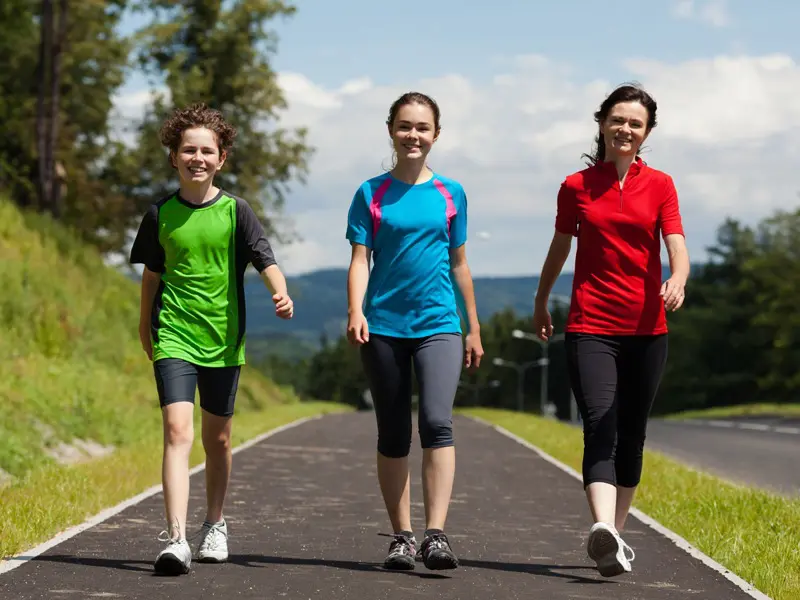
One of the easiest and best workouts for general health is walking. It is appropriate for individuals of all ages and fitness levels, doesn’t require any special equipment, and can be done both indoors and outdoors. Frequent walking strengthens bones and muscles, promotes weight control, enhances cardiovascular health, and elevates mood by releasing feel-good chemicals.
Even a quick stroll around your house, on the patio, or in your neighborhood can improve blood flow, increase joint suppleness, and lower your chance of developing long-term conditions like diabetes and high blood pressure. Walking is a fantastic technique to keep active and healthy at home because of its many advantages and little impact.
Kegel exercises:
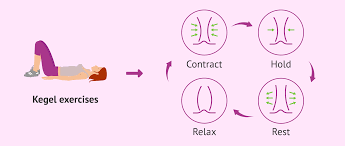
They are easy yet very effective. These exercises are particularly helpful for promoting reproductive health, strengthening core stability, and increasing bladder control. Kegel exercises can be used by both men and women to prevent or treat conditions including pelvic organ prolapse and urine incontinence.
They may be performed quietly at any time, whether you’re seated, standing, or lying down, and they include regularly tightening and releasing the pelvic muscles. Kegel exercises are a great complement to any at-home fitness program that emphasizes general wellness since they involve little time and no equipment.
Push-ups:
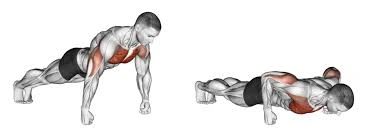
They are a great full-body exercise for increasing strength and endurance since they mainly work the muscles in the chest, shoulders, triceps, and abdomen. From beginner-friendly knee push-ups to more complex versions like diamond or decline push-ups, they may be readily adjusted to accommodate varying fitness levels. Push-ups are a simple and effective activity to incorporate into your at-home training regimen for general health and fitness because they require no special equipment and take up very little room.
Squats:
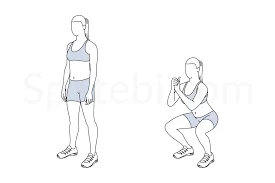
Strengthening the muscles surrounding the knees and hips is crucial for everyday tasks like walking, climbing stairs, and lifting items, and squats assist in achieving this. With variants like jump squats or goblet squats, this functional exercise may be readily altered or escalated while increasing metabolism and supporting joint health. Squats are an easy yet effective workout that can be done at home without any special equipment to improve strength, mobility, and general health.
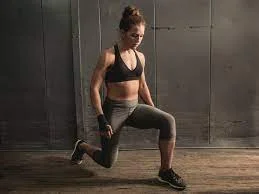
Lunges are great for functional fitness because they help improve coordination, increase joint flexibility, and address muscle imbalances. Lunges may be readily modified to accommodate varying levels of fitness, whether they are done in situ, while walking, or with additional weights. Regularly performing lunges at home, without the need for any additional equipment, improves posture, tones the legs and glutes, and enhances general health and mobility.
Running:
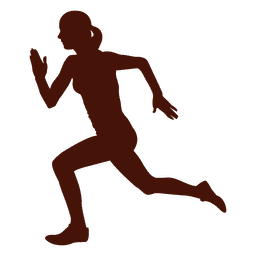
It strengthens the lower body muscles, particularly the legs and core, increases endurance, helps maintain a healthy weight, and enhances heart and lung function. Running is also known as “runner’s high” because it releases endorphins, which improve mood and lower stress. Running is a great method to remain in shape and burn calories, whether you do it in your yard, on your terrace, or anywhere else in your house. Running regularly at home, together with a suitable warm-up and cool-down, may greatly enhance mental and physical health.
Planks:
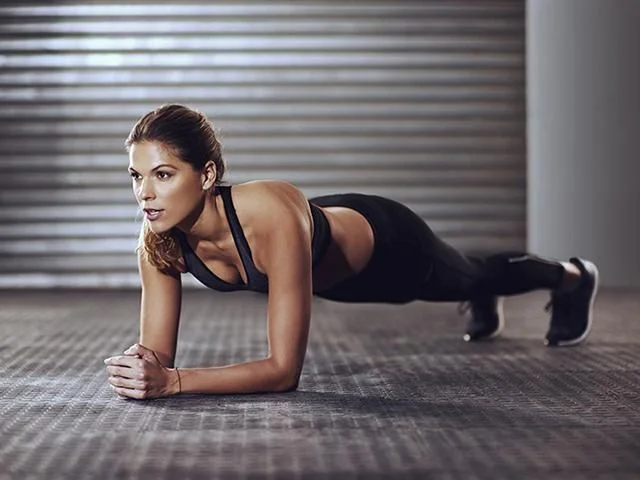
The abdominals, back, shoulders, chest, and legs are just a few of the muscular groups that are worked out by the very efficient core exercise known as planks. This static bodyweight exercise supports spinal health, lowers the chance of injury, and enhances posture, core strength, and stability.
Without the need for any special equipment, planks improve general muscle coordination and endurance. Planks are an easy addition to any at-home exercise regimen, regardless of whether you try more complex versions or stick to a basic forearm plank. Regular plank practice improves balance, strengthens the core, and increases general fitness.
Side planks:
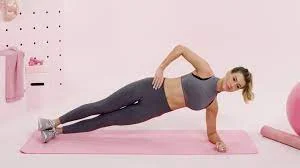
An effective core-strengthening exercise, side planks work the muscles on the sides of your belly, as well as your shoulders, hips, and lower back. This bodyweight exercise lowers the risk of back pain and injury while enhancing posture, balance, and core stability. Side planks, in contrast to standard planks, emphasize lateral strength, which is crucial for general functional fitness. They are ideal for a home fitness regimen since they don’t require any special equipment and can be done in a small area. Regularly adding side planks promotes a stronger, more balanced core for improved mobility and general health.
Glute bridge:
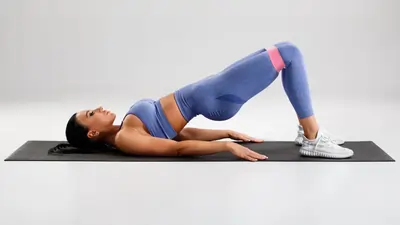
Targeting the gluteal muscles, hamstrings, lower back, and core, the glute bridge is a straightforward yet effective exercise. It works particularly well to improve posture, spinal alignment, pelvic stability, and hip strength. All fitness levels, including novices and those recuperating from injuries, may benefit from this low-impact, kinder activity. The frequently underutilized glute muscles, which are necessary for balance and daily motions, are also activated, and lower back pain is lessened with glute bridges. Glute bridges are a great complement to any at-home exercise program aimed at increasing strength and enhancing general health because they require no special equipment.
Dumbbell rows:
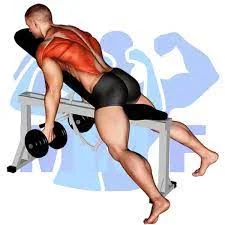
They aid in muscular growth, posture correction, and pulling strength enhancement, all of which are critical for everyday tasks like lifting and hauling. Additionally, this exercise works the core, which enhances balance and stability. Dumbbell rows are perfect for at-home workouts since they only take up a little amount of space and can be performed with one or two dumbbells. Dumbbell rows are a great way to strengthen your back and improve the general health and function of your upper body, whether you execute them hunched over or supported by a bench or chair.
Overhead dumbbell presses:
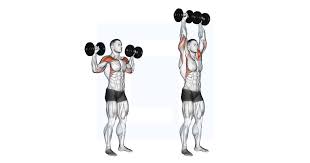
An effective upper-body workout that mainly works the shoulders, triceps, and upper chest is the overhead dumbbell press. This exercise is beneficial for improving posture and general strength because it also uses the core to keep the lift balanced and stable. Regularly performing this exercise supports everyday tasks that require pushing or lifting above and strengthens the shoulders and muscles. It is a practical alternative for at-home workouts because it can be performed either sitting or standing and simply requires a pair of dumbbells. Dumbbell presses performed overhead are a great way to build powerful, useful upper-body muscles and increase general fitness.
Crow Stand:
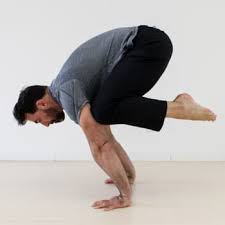
It improves wrist strength and coordination while concentrating on the arms, shoulders, and abdominal muscles. As you learn to balance your body weight on your hands, practicing the crow stand improves your confidence, focus, and body awareness. Even though it can seem difficult at first, it is safe to do at home on a yoga mat with regular practice and the right development. An effective addition to a home workout regimen for enhancing general control, strength, and balance is the crow stand.
Single-leg deadlifts:
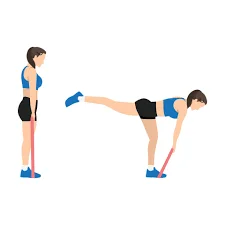
They improve muscular stability, balance, and coordination by training one leg at a time, particularly in the hip and ankle regions. This exercise is great for preventing injuries and improving general mobility because it also uses the core extensively to maintain posture and control. Single-leg deadlifts are ideal for at-home exercises since they require little equipment and space, whether they are done with body weight alone or with additional resistance like dumbbells. They are an excellent option for improving functional mobility and lower body strength in daily life.
Burpees:
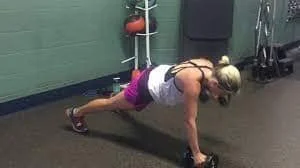
Burpees are a full-body, high-intensity workout that blends cardio and strength for an effective workout. They are great for burning calories and enhancing cardiovascular fitness since they work several muscle groups, such as the arms, legs, core, and chest, while quickly raising the heart rate. Additionally, burpees improve coordination, agility, and endurance. Even though they are difficult, they are perfect for at-home workouts since they don’t require any special equipment and can be done in a small area. With just a few minutes of daily work, adding burpees to your regimen increases your general strength, stamina, and metabolism, assisting you in maintaining your fitness and energy levels.
Mountain climber:
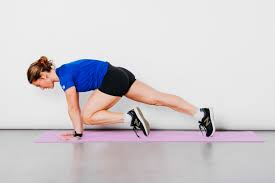
Mountain climbers mix aerobic training with core development in a dynamic, full-body workout. This exercise, which is done in a plank posture, increases heart rate considerably while working the legs, shoulders, chest, and stomach. They are ideal for at-home exercises because they don’t require any equipment and take up very little room.
Shoulder Taps:
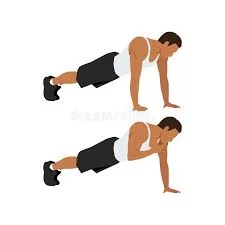
Shoulder taps are a straightforward yet powerful bodyweight exercise that strengthens the arms, shoulders, and core while enhancing stability and balance. This exercise, which is done from a plank posture, requires the hips and core to remain stable as you tap each shoulder with the opposing hand. Shoulder taps improve posture, improve coordination, and develop the deep abdominal muscles. They are perfect for at-home workouts because they don’t require any special equipment and can be completed in a compact area.
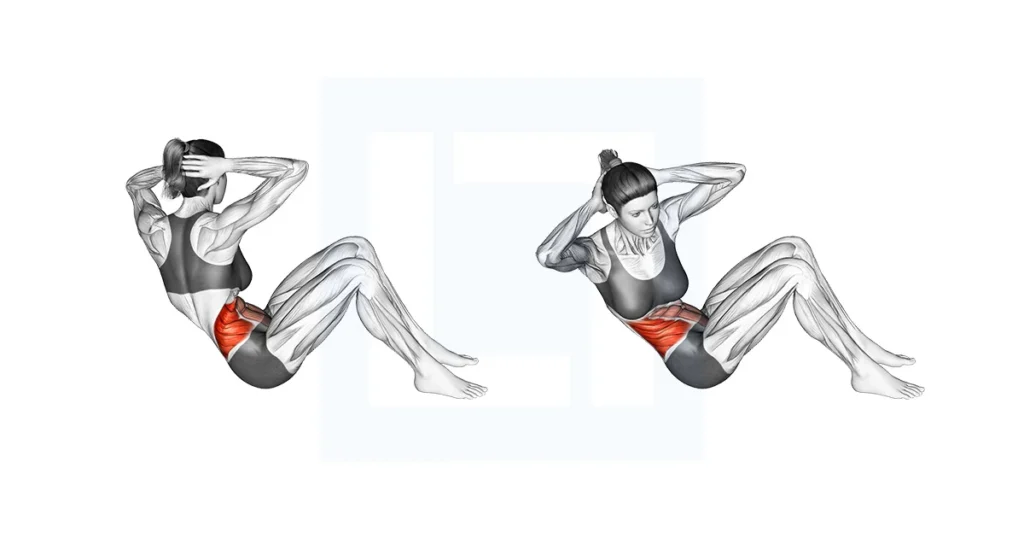
A core-focused exercise that works well for the obliques, abs, and lower back is the Russian twist. This twisting action strengthens the sides of the abdomen and improves rotational mobility and core stability when done while seated with feet up or on the floor with a little lean. Additionally, it enhances posture, balance, and coordination.
For added resistance, you can use a medicine ball or a dumbbell, or you can use only your body weight. The Russian twist is an excellent complement to any at-home exercise program that aims to develop a strong and defined core since it is easy to perform, takes up little room, and is quite effective.
Cycling:
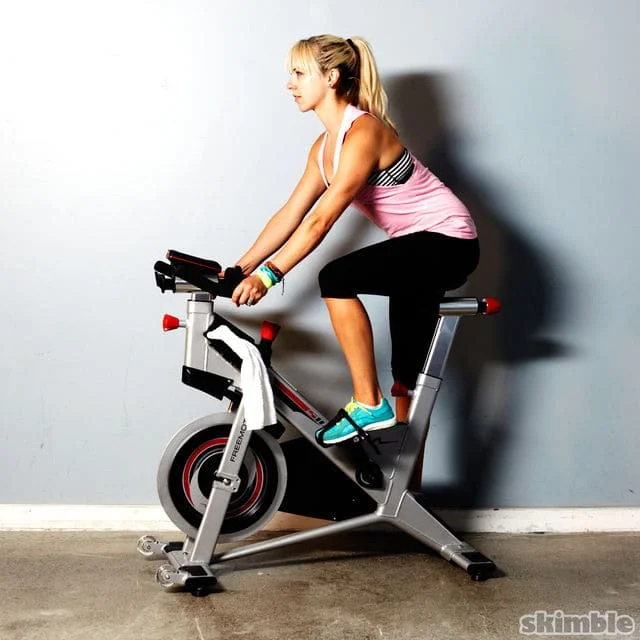
Cycling is a great low-impact cardiovascular workout that increases endurance, strengthens the legs, and benefits the heart and lungs. Riding a bike, whether it’s a stationary bike at home or a regular bicycle in your neighborhood, helps you burn calories, gain strength in your lower body, and feel less stressed. All fitness levels, including novices and those with joint issues, can benefit from it because it is easy on the joints. Indoor cycling is a quick and efficient method to remain in shape, keep healthy, and stay motivated while working out at home, all in the comfort of your own home.
Dancing:
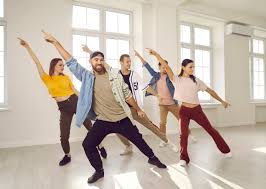
Dancing is an enjoyable, energizing, and efficient full-body workout that improves mental and physical health. Along with improving balance and endurance, it also improves cardiovascular health, coordination, flexibility, and muscular tone. Dancing is a fantastic method to keep active and fit without feeling like you’re working out since it works different muscle areas and burns calories. Dancing doesn’t require any special equipment and can be done in any part of your house, whether you follow a program, freestyle to your favorite music, or try a dance-based workout like Zumba.
Jogging:
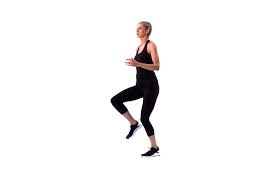
Jogging is an easy and efficient cardiovascular workout that improves lung capacity, heart health, and general endurance. By generating endorphins, which lower stress and elevate mood, it helps with weight control, lower body muscle strength, and mental clarity. Jogging is a practical alternative for at-home workouts since it can be done anywhere, on a treadmill, or in open spaces like your terrace or hallway. Jogging is a fantastic all-around activity for both physical and mental well-being since it increases endurance, maintains healthy joints, and encourages better sleep when done consistently.
Wall Sits:
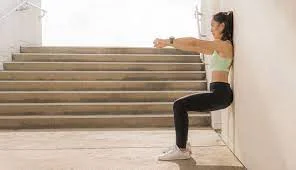
This workout, which is done while sitting against a wall without a chair, increases leg strength, mental tenacity, and muscular endurance. They are perfect for at-home exercises since they require little room and no equipment. Particularly for novices or anybody wishing to strengthen their legs without high-impact exercises, wall sits can enhance overall muscle endurance, promote joint health, and boost lower-body strength.
Superman:
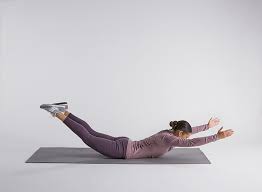
The muscles along the back of the body, known as the posterior chain, are strengthened by this exercise and are crucial for maintaining good posture, supporting the spine, and preventing injuries. Superman is a great addition to any at-home exercise program that focuses on general strength and balance because it requires no special equipment and takes up very little room.
Jump Rope:
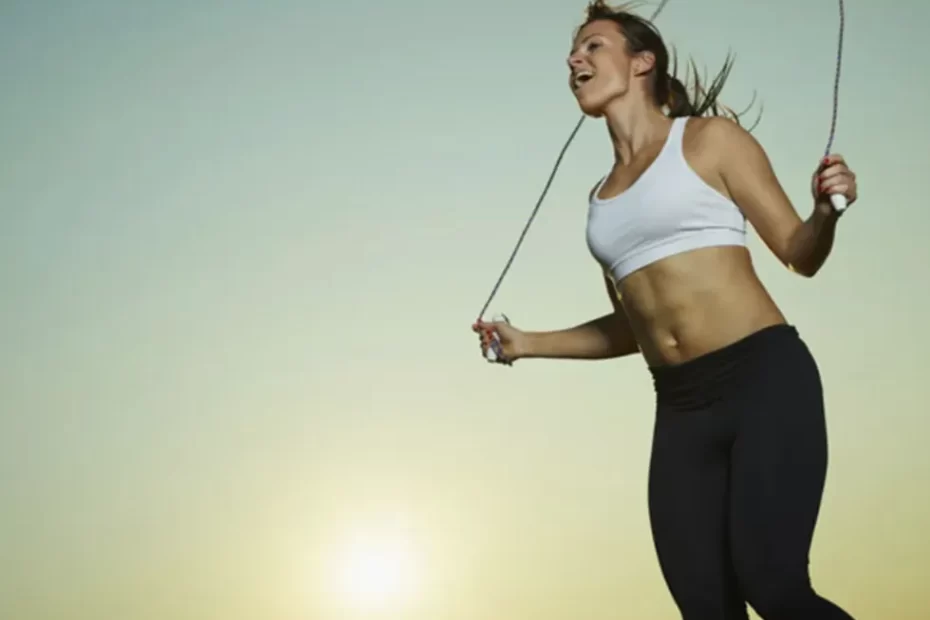
Jumping rope is a time-efficient technique to assist weight management and improve cardiac fitness since it may burn a lot of calories in only a few minutes. It’s also great for increasing rhythm and bone density. Jump rope is a portable, lightweight, and space-efficient activity that is great for at-home exercises and offers both enjoyment and fitness advantages.
Jumping Jacks:
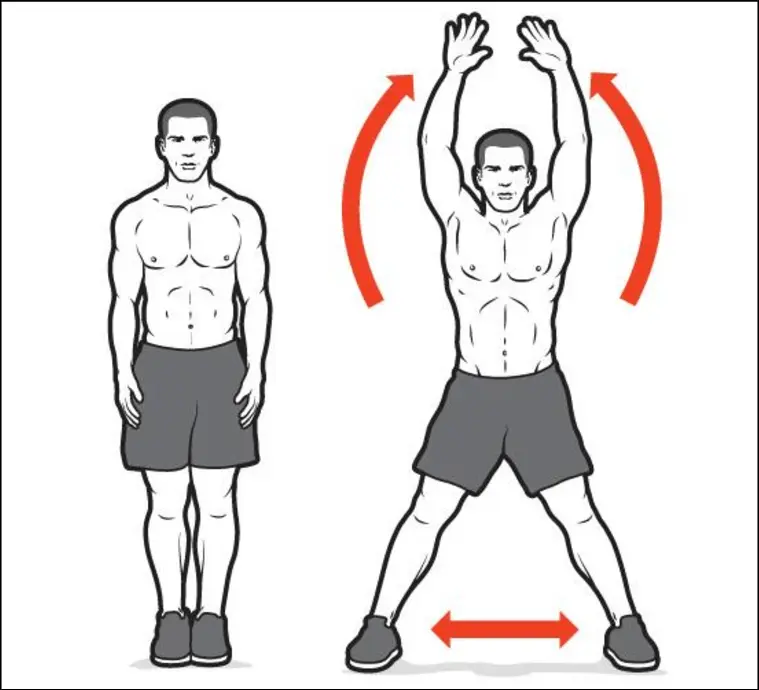
A traditional full-body aerobic exercise that enhances cardiovascular endurance, flexibility, and coordination is the jumping jack. This dynamic exercise works the arms, shoulders, legs, and core, among other muscle groups, making it an excellent warm-up or stand-alone cardiovascular workout. They may be performed in even the smallest area of the house and don’t require any special equipment. Jumping jacks are a quick and efficient technique to maintain general health and revitalize your body, regardless of your level of experience.
Yoga:

Yoga is a comprehensive mind-body practice that enhances flexibility, strength, balance, and mental clarity by combining physical postures, breathing exercises, and meditation. Aligning the body and soothing the mind, it encourages relaxation, lowers tension, and boosts general well-being. Frequent yoga practice improves posture, strengthens muscles and joints, increases immunity, and can help control long-term health issues, including high blood pressure and back pain.
Yoga can be done at home with just a mat and comes in a variety of forms, from easy stretching to more intense flows, making it suitable for people of all fitness levels. It’s an effective technique for fostering both inner serenity and physical wellness.
Shoulder blasts:
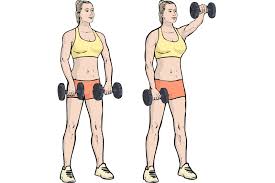
Shoulder blasts are focused exercises intended to tone and develop the shoulder muscles, especially the rotator cuff, deltoids, and traps. High-rep, low-weight, or bodyweight movements like arm circles, shoulder taps, overhead presses, and lateral lifts are frequently a part of these regimens. Shoulder blasts lower the chance of injury while enhancing upper body strength, posture, and shoulder stability. Since many of the exercises call for little to no equipment, they’re perfect for at-home training. Including shoulder blasts in your practice improves functional strength, maintains shoulder health, and defines the upper body.
Bear Crawl:

A full-body, bodyweight workout that enhances strength, coordination, and mobility is the bear crawl. This dynamic exercise improves balance and agility while strengthening the core, increasing cardiovascular fitness, and increasing muscular endurance. Additionally, bear crawls can improve functional movement patterns and body awareness. Bear crawls are ideal for at-home exercises since they don’t require any special equipment and take up very little room. They provide a demanding and efficient method of developing general body strength and fitness.
Balancing on One Toe:
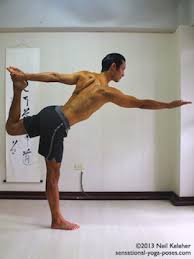
A straightforward yet incredibly powerful exercise that enhances lower body strength, stability, and coordination is balancing on one toe. It engages the core for balance control and mainly works the muscles in the calves, ankles, and feet. Proprioception, or bodily awareness, is improved by this activity and is crucial for reducing the risk of falls and enhancing performance in everyday tasks and athletics. Seniors and anybody focusing on joint stability and injury prevention would especially benefit from it.
Crab Walk:
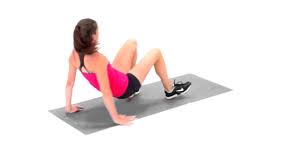
You use your hands and feet to move forward or backward while seated with your hips raised off the floor. This exercise increases stability, flexibility, and coordination while strengthening the upper and lower body. It also improves joint mobility and tests the cardiovascular system. The crab walk is a great at-home exercise alternative for developing strength, endurance, and body control in a fun but efficient manner because it requires no special equipment and takes up very little room.
Skipping:
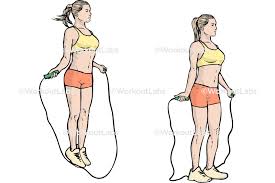
Skipping is a vigorous aerobic workout that enhances muscular endurance, coordination, agility, and heart health. It improves balance and rhythm while focusing on the arms, legs, and core. Skipping is good for managing weight and improving general fitness since it burns calories rapidly. Its repeated, rhythmic action tones muscles, strengthens bones, and enhances mental attention. It’s a simple and practical workout that can be done at home with only a skipping rope and little room. Skipping is a fun and effective method to keep in shape and motivated, whether it’s done as a warm-up or as part of a complete exercise.
Sit-ups:

This exercise promotes greater balance and stability, strengthens the core, and enhances posture. Frequent sit-up exercise contributes to the development of a stronger core, which is necessary for both injury prevention and general functional strength. They are perfect for at-home training since they only require body weight and no equipment. Simple, efficient, and easy to incorporate into any exercise program aimed at strengthening the core and improving general health are sit-ups.
High knees:
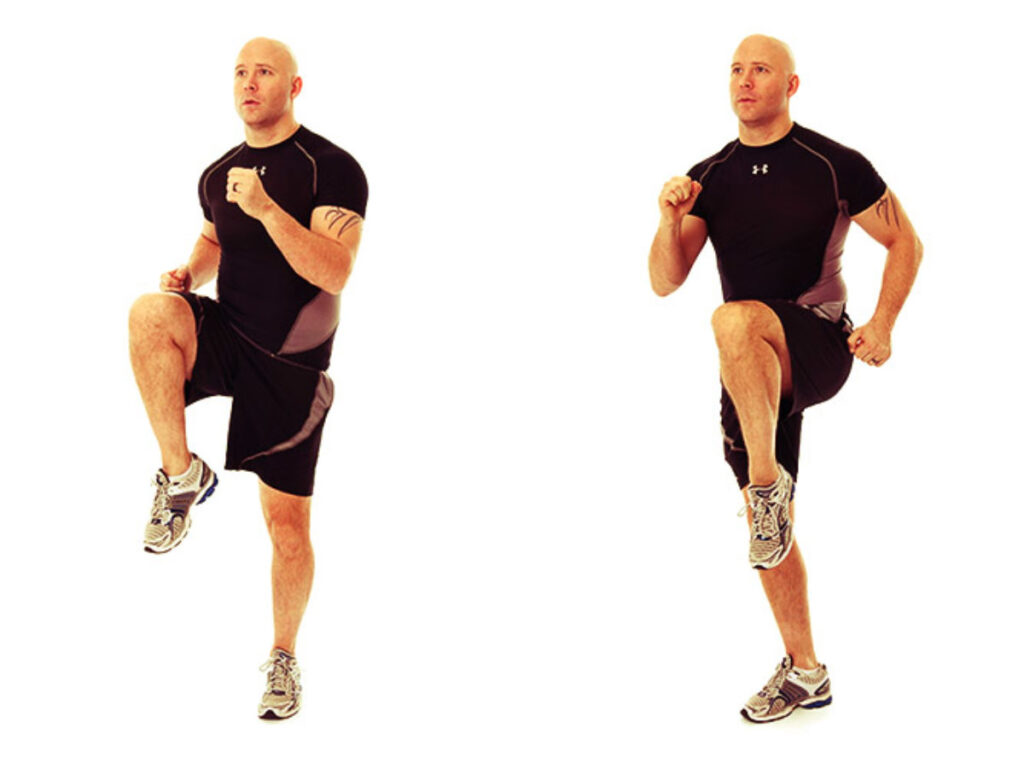
High knees are a dynamic aerobic workout that strengthens the core and lower body while efficiently increasing heart rate. This exercise, which involves sprinting in place while raising your knees as high as you can toward your chest, works your quadriceps, hamstrings, calves, glutes, and abdominals. High knees are popular in many home and sports training regimens because they improve agility, quickness, and coordination. They also speed up calorie burning and increase cardiovascular endurance. High knees are a straightforward yet effective method to boost energy, develop strength, and promote general fitness at home that requires little space and no special equipment.
Conclusion:
A gym is not necessary to be healthy and active; all you need is dedication and a few easy at-home workouts. Every activity, from cardio and weight training to movements that emphasize flexibility and balance, is essential for promoting both mental and physical health.
Including a range of these exercises in your daily routine may result in more energy, better posture, stronger muscles, and general well-being, whether you choose to do yoga for relaxation, planks for core strength, or jumping jacks for heart health.
Achieving total health at home is feasible and sustainable with regularity and the appropriate combination of exercises.
FAQs
When you can regularly work exercise into your schedule and like it, that’s the greatest time to do it. Finding a time that will allow you to maintain your fitness regimen over the long term is crucial, even if some research indicates that morning or afternoon exercises may have advantages.
Weight reduction may be achieved with either type of exercise, but the method is crucial. You may burn calories and keep your weight in check by incorporating walking into your daily routine. It may not burn calories as quickly as more strenuous exercises, but it’s a low-impact and sustainable approach to keep active.
Indeed, walking for two hours a day is typically regarded as a healthy level of physical exercise and has several health advantages. It’s sufficient to promote bone health, increase exercise, and help with weight control. But it’s crucial to pay attention to your body and make sure you’re not pushing yourself too hard, particularly when you’re beginning a new habit.
It is necessary for routine motions, such as rising off the ground or getting out of an automobile. Regular squat practice improves your stability and develops your legs, glutes, and core.
Indeed, yoga qualifies as exercise, especially when it comes to combining movement and emphasizing physical postures, or asanas. Even while yoga may be a calming and contemplative practice, many of its forms require physical effort that raises the heart rate and works muscles, meeting the requirements for exercise.
To get the most out of your workouts without going overboard with volume, it’s better to concentrate on three to five distinct leg exercises. This method guarantees that you’re not wasting time in the gym and aids in muscular growth.
It is typically not advised to perform a full-body workout every day for several reasons: Overtraining: It takes time for your muscles to grow and heal. Overtraining can happen from working out the same muscles every day, which can cause weariness, poor performance, and even injury.
In this activity, you are asked to see your life as good as it can be and then write about this ideal scenario. According to studies, doing this will not only make you happier now but also open the door to long-term, consistent happiness.
Indeed, for many people, walking can serve as sufficient exercise, particularly when done frequently and quickly. It has several health advantages, including stronger muscles, a better mood, and better cardiovascular health. Walking may be a fantastic starting point for an active lifestyle, while some people may benefit from adding other types of exercise.
Cardiovascular activity, which tones the heart and burns calories, should be a part of any fitness regimen. Additionally, most people can walk anywhere, at any time, and with only a decent pair of shoes.
Walking is easy yet effective. It can help you maintain a trim figure, lessen your risk for several diseases (such as diabetes and heart disease), strengthen your bones, improve your cholesterol, control your blood pressure, and boost your mood.
Generally speaking, a strength training session should consist of four to six movements. This is especially true if you’re doing complex exercises, like squats and deadlifts, that target several main muscle groups simultaneously.
References:
- Harvard Health. (2024e, February 20). 5 of the best exercises you can ever do. https://www.health.harvard.edu/staying-healthy/5-of-the-best-exercises-you-can-ever-do
- Davis, N. (2025n, May 1). 30 moves to make the most of your At-Home workout. Healthline. https://www.healthline.com/health/fitness-exercise/at-home-workouts
- Sarnataro, B. R. (2024b, January 9). The 7 most effective exercises. WebMD. https://www.webmd.com/fitness-exercise/features/7-most-effective-exercises
- 6 simple exercises to add to your next at-home workout | Kaiser Permanente. (2025c, February 13). Kaiser Permanente. https://healthy.kaiserpermanente.org/health-wellness/healtharticle.7-simple-exercises-you-can-do-at-home
- Neudecker, K. (2025d, February 14). 45 of the Best Exercises to Boost Your Home Workout Gains. Men’s Health. https://www.menshealth.com/uk/building-muscle/a754099/the-15-best-beginners-exercises-to-do-at-home/
- Exercises to do for a full-body, at-home workout. (n.d.). Iodex. https://www.iodex.co.in/health-wellness-pain/exercise-diet/exercises-to-do-at-home/
- Sissons, B. (2020b, December 22). What are the best exercises for overall health and fitness? https://www.medicalnewstoday.com/articles/best-exercises
